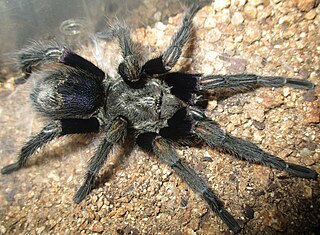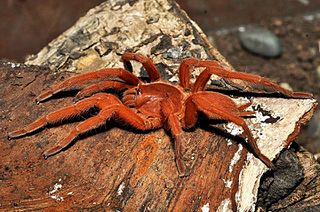Related Research Articles

Selenocosmia is a genus of tarantulas that was first described by Anton Ausserer in 1871. The genus is found in China, New Guinea, Indonesia, Australia, Indonesia, Myanmar, Malaysia, Laos, Vietnam, Philippines, India and Pakistan. They are commonly referred to as whistling or barking spiders, due to their ability to stridulate using lyra hairs.

Euathlus is a genus of South American tarantulas that was first described by Anton Ausserer in 1875. These spiders are medium sized and are usually found in high elevations in the Andes. It is a senior synonym of Paraphysa, and was formerly considered a senior synonym of Brachypelma, but this was later rejected.

Tarantulas comprise a group of large and often hairy spiders of the family Theraphosidae. As of December 2023, 1,100 species have been identified, with 166 genera. The term "tarantula" is usually used to describe members of the family Theraphosidae, although many other members of the same infraorder (Mygalomorphae) are commonly referred to as "tarantulas" or "false tarantulas". Some of the more common species have become popular in the exotic pet trade. Many New World species kept as pets have setae known as urticating hairs that can cause irritation to the skin, and in extreme cases, cause damage to the eyes.

The skeleton tarantula, Ephebopus murinus, is a species of spider belonging to the family Theraphosidae (tarantulas), sub-family Aviculariinae. A New World species, it is native to several South American countries. Its common name is derived from the skeleton-like markings on its legs.

The Theraphosinae are a large subfamily of Mygalomorphae spiders in the family Theraphosidae found in the Neotropical realm.

Ephebopus is a genus of northeastern South American tarantulas that was first described by Eugène Louis Simon in 1892. Its relation to other tarantulas is one of the most uncertain in the family, and it has been frequently moved around and has been placed in each of the eight subfamilies at least once.

The Stromatopelminae are a subfamily of tarantulas native to West Africa and part of Central Africa. The subfamily was first proposed by Günter Schmidt in 1993.
Sickius is a genus of tarantulas. It has a single species, Sickius longibulbi. It is endemic to Brazil.
Hapalotremus is a genus of South American tarantulas in the Theraphosinae subfamily that was first described by Eugène Louis Simon in 1903. They have red or white Type III urticating hairs, up to 1.2 millimetres (0.047 in), with a fine point and barbs along at least half of the lower part. The tibial apophysis is branched twice, and there is a conspicuous subapical keel on the male's embolus.
Bistriopelma is a genus of spider, being a theraphosine theraphosid (tarantula).
Bistriopelma matuskai is a species of tarantula, in the theraphosinae subfamily, which is only known from Peru.

Orphnaecus is a genus of tarantulas that was first described by Eugène Louis Simon in 1892. They have close to fifty lanceolate stridulatory spines on the chelicerae, known as "strikers". The male embolus has a single strong retrolateral keel. It is considered a senior synonym of Chilocosmia and Selenobrachys.
Orphnaecus dichromatus is a species of selenocosmiine tarantula, in the Phlogiellini tribe.

Phlogiellus is a genus of tarantulas that was first described by Reginald Innes Pocock in 1897. They are found throughout Asia and Papua New Guinea, including Indonesia, the Philippines, Papua New Guinea, China, Myanmar, Malaysia, Borneo, Thailand, the Solomon Islands and Taiwan. Phlogiellus is part Latin and part Greek, the first part being "φλóξ φλoγóϛ", meaning flame, the second part being "ellus" which is a latin diminutive suffix.
Coremiocnemis is a genus of tarantulas that was first described by Eugène Louis Simon in 1892. They are named after the greek words korema, which means broom or brush, and kemis, meaning shin guard. Being a reference to the hirsute characteristics of the posterior legs.
Psednocnemis is a genus of Southeast Asian tarantulas that was first described by R. C. West, S. C. Nunn & Henry Roughton Hogg in 2012.

The Selenocosmiinae are a subfamily of tarantulas found throughout South-East Asia and Australia. This subfamily is defined by the presence of a lyra on the maxillae and strikers on the chelicerae, allowing these spiders to stridulate and produce a "hissing" sound. However some species within Phlogiellus may have secondary lost their lyra but retain their strikers. The monophyly of the subfamily has been only tested using genetic data with a handful of genera or species in a few studies. However, these studies found genera that had been previously placed in this subfamily were actual their own separate subfamily (Poecilotheria) and that Selenocosmiinae is most closely related to the Indian Thrigmopoeinae. As of 2021, Selenocosmiinae contains 11 genera.
Antikuna is a genus of South American tarantulas. It was first described by Radan Kaderka, N. Ferretti and M. Hüsser in 2021, and it has only been found in Peru.
Hapalotremus chespiritoi is a tarantula in the Hapalotremus genus, first described by Nelson Ferretti, Patricio E. Cavallo, Juan C. Chaparro, Duniesky Ríos Tamayo, Tracie A. Seimon and Rick C. West in 2018. It is found in Peru, Patambuco, very close to Sicuani. This tarantula is named after Roberto Gómez Bolaños. The shape of the spermatheca of female of Hapalotremus chespiritoi resembles the small antennae of el "Chapulín Colorado", a comical superhero created by R.G. Bolaños.
References
- 1 2 "Profile: Rick C West - Birdspiders.com". birdspiders.com. Retrieved 2017-05-11.
- ↑ "Tarantula! || TPW magazine | March 2010". tpwmagazine.com. Retrieved 2017-05-11.
- ↑ "Lasiodora - Váš web o chove vtáčkarov". lasiodora.sk. Retrieved 2017-05-11.
- ↑ "Rick West - IMDb". imdb.com. Retrieved 2017-05-11.
- ↑ West, Rick C.; Marshall, Samuel D.; Fukushima, Caroline Sayuri; Rogério, Bertani (2008). "Review and cladistic analysis of the Neotropical tarantula genus Ephebopus Simon 1892 (Araneae: Theraphosidae) with notes on the Aviculariinae" (PDF). Zootaxa . 1849: 35–58. doi:10.11646/zootaxa.1849.1.3. eISSN 1175-5334. ISSN 1175-5326.
- ↑ Rick, C. West; Nunn, Steven C. (2010). "A taxonomic revision of the tarantula spider genus Lyrognathus Pocock 1895 (Araneae, Theraphosidae), with notes on the Selenocosmiina" (PDF). Zootaxa . 2362: 1–43. eISSN 1175-5334. ISSN 1175-5326.
- ↑ "A nature photographer's hairy moment in UAE leads to discovery of a new species of spider | The National". thenational.ae. Retrieved 2017-05-11.
- ↑ Christine Dell'Amore. "Puppy-Size Tarantula Found: Explaining World's Biggest Spider – National Geographic Society (blogs)". voices.nationalgeographic.com. Archived from the original on October 31, 2014. Retrieved 2017-05-11.